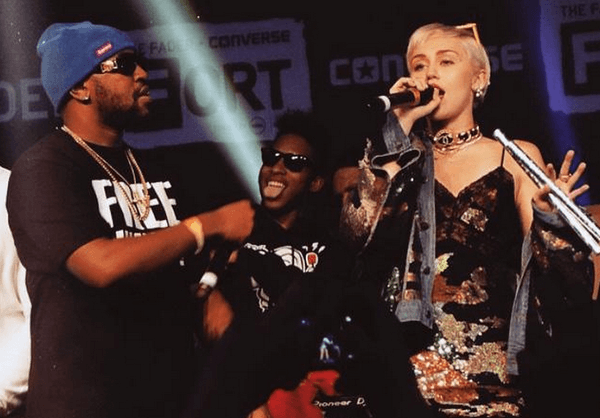The future, it turns out, smells like stale beer and burning “trees.” On a Thursday night in Austin, Texas, a crowd of festival goers embraced the mingling aromas to experience pop star Miley Cyrus perform with Mike Will Made-It, Atlanta rap artist and producer of Cyrus’ breakout album,”Bangerz,” at the Fader Fort stage.
Miley Cyrus’ appearance was not published on any official lineup. Rather, festival attendees learned of the event only a few hours before Cyrus stepped onstage through rumors started on digital channels.
Word of the surprise performance was promoted first as speculation and then confirmed through social media. Early mentions of the possibility of an appearance were seeded by influencers on the ground in Austin.

As the rumors gained traction, simple confirmation by The Fader Twitter account followed:

The result was high volume attendance and a line over 1/4 mile long at the venue entrance. By leveraging social media and identifying strategically selected local influencers, organizers were able disseminate news of Miley Cyrus’ performance to a diverse audience to see results in a short period of time. Digital media has matured to become a legitimate–and highly effective–method for customer activation. Offline events like SXSW provide the landscape upon which marketers and strategists are able to design unique, brand-led experiences. In the Quarterly Digital Intelligence Briefing, published by Econsultancy and Adobe, marketers reported advances in social technologies as presenting the most exciting opportunities across industries. Based on the report, marketers across industries agreed on four key trends:
- Customer experience is imperative to brand success
- Engaging social on mobile content is a top priority
- Targeting and personalization should be integral to overall strategy
- Companies need easy ways to inject analytics and data into already-existing infrastructure
As illustrated beneath that crowded plastic tent in a hazy fog on a weeknight in Austin, brands that have figured out how to connect with targets–on their own terms–reap tangible rewards by completing the online-offline-online audience-experience loop. Developing a relationship with customers typically requires the customer feels an emotional connection to the brand. In order to nurture this kind of loyalty, brands create experiences for customers to enjoy. SXSW, dubbed the “marketing playground” by industry rags, has morphed into a festival catering to the consumer by understanding first audience demographics and psychographics, followed by brand-driven experience-based implementation. Once an understanding of key interests within the artists’ audiences and the larger event audience is established, marketers are able to strategically craft showcases that emphasize brand goals and affiliate sponsors–in Fader Fort’s case, Dell and Intel–with an on-trend experience. Expanding upon psychographic data, brands target and personalize experiences by engaging consumers through the preferred channels. At SXSW, data collected by People Pattern shows that 93% of attendees engaged with brands and sponsors on social media from their smartphones, indicating that mobile-optimization and social engagement would be critical to brands’ overall event strategies. Personalized content targeted to specific audiences through relevant brand messaging and/or influencer engagement empowers brands to leverage online outlets to drive offline activation and encourage positive, shareable, brand-led experiences for customers.

Social media needs events like SXSW. There is a symbiotic relationship between digital networks and live events that decides the success of both. Online communications fuel offline experience and customer loyalty. At the heart of it all lie data and analytics tools that provide marketers the means to design creative experiences for customers that are grounded in metrics and measurable in success.
Digital marketing does not replace traditional marketing methods, but rather adds another layer of involvement and efficiency to audience activation. Fader Fort was not alone in the use of social media to generate buzz and drop news–from McDonalds to Yahoo, RayBan to Samsung, brands across industries took advantage of social platforms to elevate the customer experience. In this way, the use of social media successfully drove audience activation by effectively generating buzz, enhancing perception and providing positive customer experiences on behalf of the brands, the entertainers and corporate sponsors.
People Pattern helps brands connect with the right partners to optimize event opportunities and sync off- and on-line engagement by providing audience insights based on the unique interests of brand audiences. For more information about how the platform can benefit your brand, opt in for a demo and someone from our team will be with you in no time.



Recent Comments